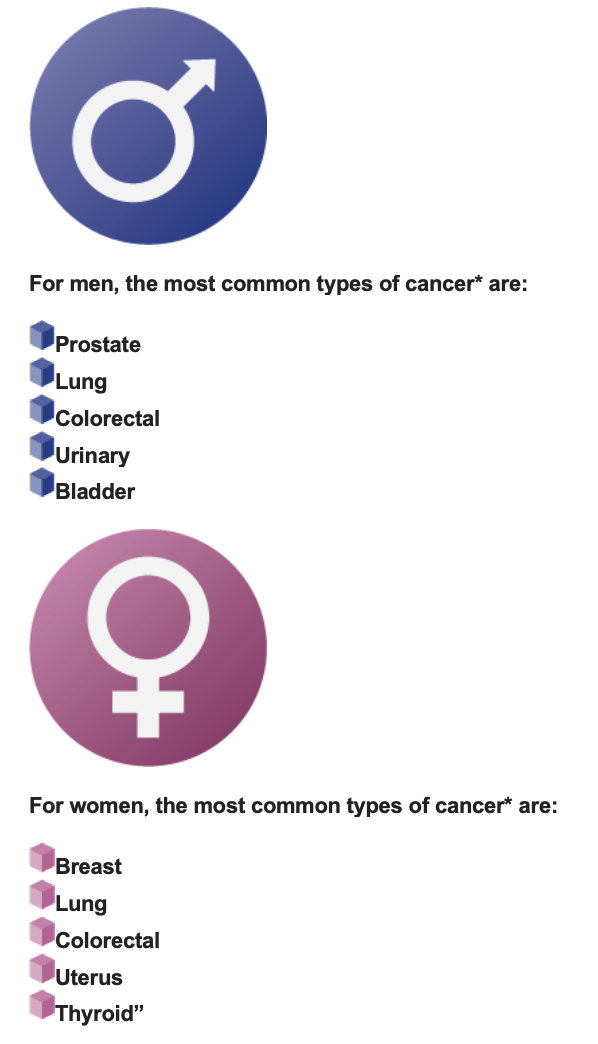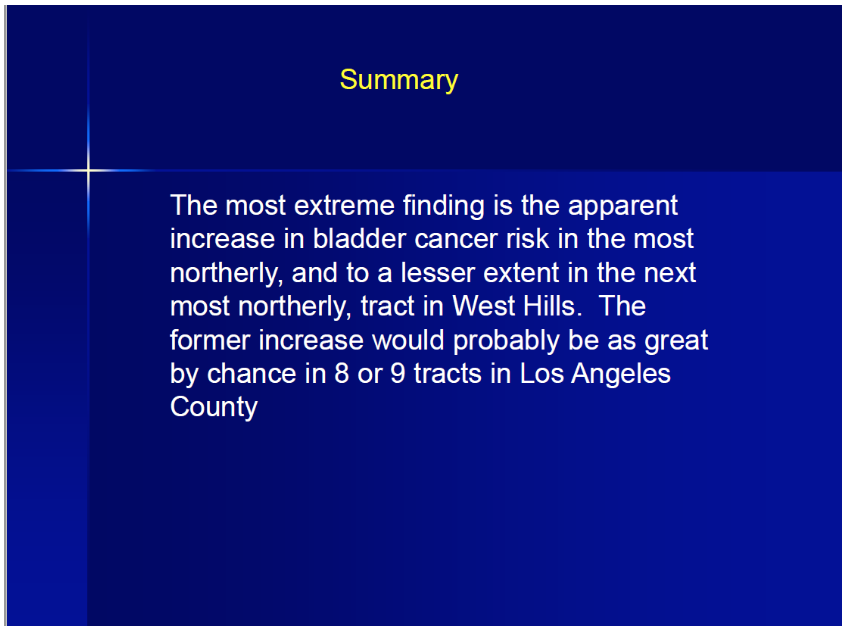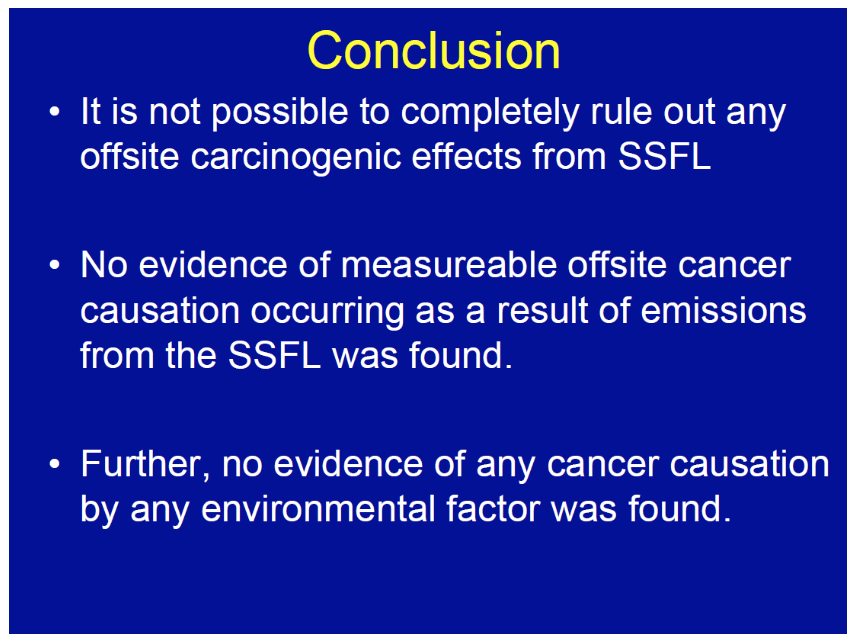CommentsENVIRONMENT POLITICS--Why is the Santa Susana Field Laboratory (SSFL) so important to the community of West Hills? According to the map above, most of West Hills is within the five-mile radius of the SSFL site. The numbers on the map above are the census tract numbers included in studies by Dr. Thomas Mack and other epidemiologists.
I first became involved with the Santa Susana Field Laboratory (SSFL) issue in the fall of 2006. My younger son was going “LARPING” (Live Action Role Playing) at Sage Ranch. He wanted to camp there, but I had read newspaper stories that talked about chemicals from the SSFL site potentially migrating offsite. Since Sage Ranch is adjacent to the SSFL site, I was worried that he may be exposed to those contaminants. So I did not allow him to camp there.
I attended my first meeting related to the SSFL site at the West Hills Neighborhood Council (WHNC). I don’t know why I attended the meeting, but I saw a PowerPoint presentation by one of the WHNC Board members. At that time, the Board members and stakeholders were concerned about finding perchlorate in Dayton Canyon at very high levels. The SSFL Dayton Canyon drainage runs into Dayton Canyon in West Hills.
I began to attend every meeting that I was aware of related to the SSFL site. I believed all of the people who attended the “SSFL Workgroup” meetings as to their knowledge of what had occurred historically related to the SSFL site. I heard stories of “Cancer Clusters.” I naively believed the people who were writing about the SSFL site. I would often search far and wide for sources of information (the original sources) when I would write about the SSFL site, but once I could not find a primary source, so I quoted and gave credit to the other source of that information.
In 2008, I was appointed to the Board of the West Hills Neighborhood Council (WHNC). I had already become a stakeholder member of the “Dayton Canyon Committee.” That committee later became the “Santa Susana Mountain Area Committee” to include Dayton Canyon and the whole SSFL site. Ultimately, its name was changed to the “WHNC Environment Committee.” We would discuss the concerns of the stakeholders of West Hills, Simi Valley, etc., regarding offsite risks and cancer in our community.
In 2010, as the WHNC Public Health Committee Chair, I contacted the California Cancer Registry.
“CCR is a program of the California Department of Public Health's Chronic Disease Surveillance and Research Branch (CDSRB). The CCR is California's statewide population-based cancer surveillance system. We collect information about almost all cancers diagnosed in California. This information furthers our understanding of cancer and is used to develop strategies and policies for its prevention, treatment, and control. The availability of data on cancer in the state allows health researchers to analyze demographic and geographic factors that affect cancer risk, early detection, and effective treatment of cancer patients. The data also help determine where early detection, educational, and other cancer-related programs should be directed. The CCR is recognized as one of the leading cancer registries in the world and has been the cornerstone of a substantial amount of research on cancer in the California population. To date the CCR has collected detailed information on over 7 million cases of cancer among Californians diagnosed from 1988 forward, and more than 175,000 new cases are added annually.”
“ABOUT CANCER - There are many types of cancer. Cancer can start anywhere in the body. The way it grows and spreads depends on many factors, including which type of cancer it is and where it started. The longer people live, the more likely it is that they will get cancer. Today, more people are living with and surviving cancer than ever before.”
“Cancer in California - Despite the fact that cancer incidence and mortality rates are declining, it is estimated that nearly I out of every II Californians born today will develop cancer at some point in their lives, and it is likely that 1 in 4 people with cancer will die of cancer.
In California, more than 176,140 people will be diagnosed with some form of cancer this year.* This is equivalent to more than 20 new cases every hour of every day.”
“Who gets cancer?
Cancer can strike at any age. However, in California, more than 50% of the cancers diagnosed are among people aged 65 and older, who make up only about 11% of the population.
There are also differences in cancer rates among adults depending on the type of cancer and race/ethnic group.”
“The most common types of cancer also differ based on sex, although skin cancer is common for both sexes

“Can cancer be prevented or stopped?
Many cancers can be cured if detected and treated promptly, and many others can be prevented by lifestyle changes, including avoidance of tobacco, consuming a healthy diet, and being physically active.
The current estimate in the recent California Cancer Facts and Figures is that more than 1,492,000 Californians who are alive today have a history of cancer.†Many of these individuals have no further evidence of the disease and have the same life expectancy as people who have never been diagnosed with cancer.
*This does not include people with common skin cancers.
†This does not include basal or squamous cell carcinomas of the skin or certain non-invasive cancerous conditions of the uterine cervix.”
“ACCESSING CCR DATA - The main goal of cancer registries is to collect and aggregate data, which is then analyzed by researchers. Analysis by researchers increases our knowledge of various cancers, which improves cancer diagnosis and treatment practices over time.
CCR is required by law to share the aggregated data that it collects. CCR provides statistics, reports, and tools that are intended for use by researchers, patients, and the general public. This includes cancer statistics for California as a whole, statistics for specific regions of California, and statistics for individual counties.
Cancer patients also have the right to access their own personal data files from CCR. Reporting of cancer cases is required by law and so, too, is the protection of the privacy and confidentiality of this sensitive data. No data may be used to identify individuals with cancer. Maintaining this confidentiality is one of our highest priorities.
This section of the site includes the following resources, many of which may be found in our Data Library:
- Cancer fact sheets
- Special reports on cancer in California
- Information for researchers who are interested in requesting data from CCR
- Information for patients or others with legal authorization who are interested in requesting an individual’s CCR case file
- The CCR Interactive Query Tool, [[[ https://www.cancer-rates.info/ca/ ]]] which provides cancer information by region
- A compiled list of publications in scientific journals that includes CCR data
- CCR Publication (June 2017 – June 2018)
- CCR Publication (2012 – 2017)
- Data and statistics on geographical variations in cancer, generated using our Geographical Information System (GIS)
CCR is committed to advancing our knowledge of cancer and is grateful for the contributions of patients, researchers, and the cancer community. Your contributions are helping to improve and extend the lives of people with cancer.”
I was trying to get the most recent information from the CCR related to cancer incidence for the community of West Hills. We had heard that there had been higher incidence of bladder cancer in West Hills, and the WHNC wanted accurate information.
I was ultimately referred to Dr. Thomas Mack. Dr. Mack is the former Chair of Cancer Surveillance for all of Los Angeles County and a Professor of Preventative Medicine at USC. He is also the current and original Chair of the Proposition 65 Committee for the State of California.
“Proposition 65, officially known as the Safe Drinking Water and Toxic Enforcement Act of 1986, was enacted as a ballot initiative in November 1986. The proposition protects the state's drinking water sources from being contaminated with chemicals known to cause cancer, birth defects or other reproductive harm, and requires businesses to inform Californians about exposures to such chemicals.
Proposition 65 requires the state to maintain and update a list of chemicals known to the state to cause cancer or reproductive toxicity.”
The West Hills Neighborhood Council Board brought Dr. Thomas Mack to their December 2010 Board meeting to explain cancer, to educate us about cancer clusters, and to tell us if we had greater incidence of cancer in our community as a result of our proximity in West Hills to the SSFL site.
This is Summary Slide for the West Hills Neighborhood Council:

In his presentation, Dr. Mack concluded that: “Interpretation: No increase was noted among female residents of the West Hills tracts, and bladder cancer generally occurs more frequently among smokers, among upper middle-class men, and among those employed in certain occupations. The observed increase is therefore not surprising.”
Please note – of the 120 slides in the West Hills slides in this link, 98 are applicable to Los Angeles County in general, and they give an excellent overview of cancer, its causes, cancer clusters, etc. The photo shown at the top of this article is from this presentation.
Residents of West Hills and other SSFL communities continued to hear about cancer in our community and potential offsite risks. In November 2010, the California Department of Toxic Substances Control (DTSC) created a Public Participation Group for the SSFL site.
At one of these meetings, DTSC was asked to bring in Dr. Thomas Mack to discuss offsite risk around the SSFL site. Unfortunately, that group was discontinued before DTSC was able to bring Dr. Mack there.
Again, as the Public Health Chair of the West Hills Neighborhood Council, I reached out to the California Cancer Registry. I asked who to contact for the Ventura County Cancer Registry data.
In December 2011, I reached out to Dr. Janet Bates, MD MPH, Chief, Cancer Surveillance Section Cancer Surveillance and Research Branch, California Department of Public Health. This is what she said in an email to me:
“I have asked Dr. Mack if he and his team would be able to do an analysis and presentation of Ventura County cancer data in relation to the SSFL site that is similar to the work done in Los Angeles County last year, and he has indicated that he can do it if we can provide him with the Ventura County data. I am making arrangements to do that now. The California Department of Public Health does contract with the Los Angeles Cancer Surveillance Program to perform evaluations on local community cancer concerns in Los Angeles County, and there is no one with more experience and expertise than Dr. Mack. Because of this experience, and particularly because of his knowledge of the SSFL history and prior evaluations, I think that he is in the best position to review this on the Ventura County side of the site. We will work with Dr. Mack and his team to provide additional support for his evaluation if needed.”
When I asked Dr. Mack how he is compensated for doing these studies, he explained to me that his salary for the California Cancer Registry is paid for by the CDC as a part of his compensation as a Professor at USC.
In April 2014, Dr. Thomas Mack finally gave his presentation at a DTSC SSFL Open House. Here is his conclusion:

That brings us to today.
- Why do so many people believe that their cancer was caused by the SSFL site?
- Some former employees were exposed to contaminants at the SSFL site which may have caused their cancers.
- Some local residents may have been exposed to contamination when this was an active site.
- However, the Federal EPA and DTSC both have indicated to members of the public that the SSFL site is secured, and that they do not believe that residents today are being exposed to chemicals or radionuclides from the SSFL today
- Why don’t our Elected Officials take the time to understand the SSFL site better in order to protect us from misinformation perpetuated by the news and social media?
(Chris Rowe has been a 41-year resident of West Hills, was a former West Hills Neighborhood Council Board Member, and has a B.S. in health education. She can be reached at [email protected].) Photo above from Dr. Thomas Mack’s Presentation: “Cancer Occurrence in Offsite Neighborhoods Near the Santa Susana Field Laboratory” – DTSC Santa Susana Field Laboratory Open House – April 2014. Prepped for CityWatch by Linda Abrams.
















